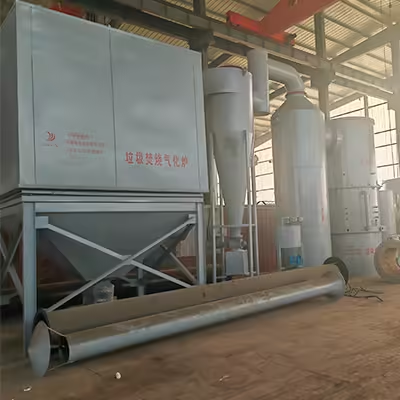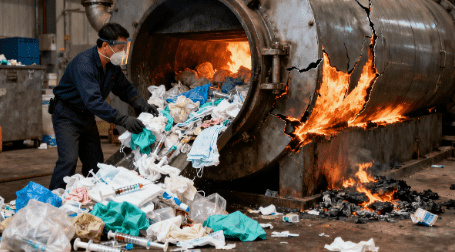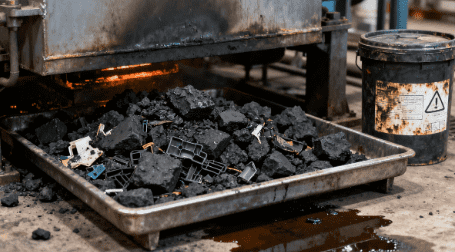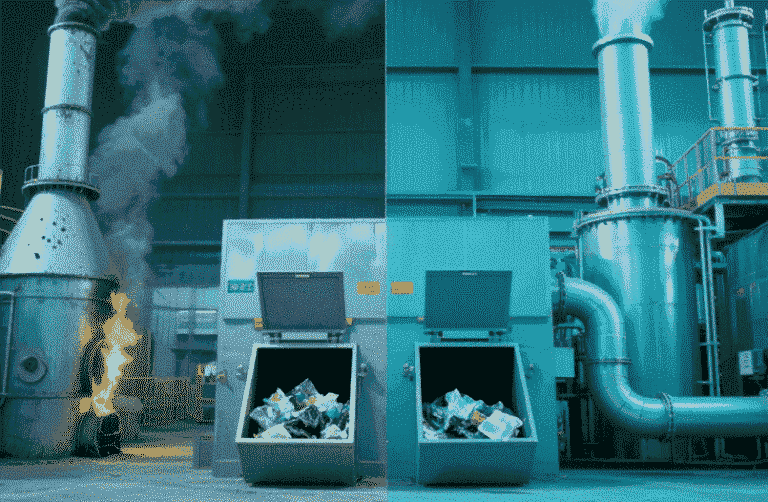Table of Contents
Introduction

Medical waste management is a critical responsibility for healthcare facilities worldwide. Hospitals, clinics, and research laboratories generate various hazardous wastes, including infectious materials, sharps, pharmaceutical residues, and chemical by-products. Incineration has been a widely adopted solution for reducing the volume of these wastes and minimizing the risk of contamination. The incinerator for medical waste is designed to destroy pathogens and convert hazardous materials into non-infectious ash, making it a seemingly convenient option.
However, relying solely on incineration comes with several alarming issues that can affect a facility’s budget, compliance status, safety, and environmental footprint. In this article, we explore three primary concerns associated with medical waste incinerators and provide actionable insights to help healthcare administrators make informed decisions.
High Operating and Maintenance Costs of Incinerator for Medical Waste
Unexpected Maintenance Expenses
Incinerator for Medical Waste are far from simple machines—they are high-tech systems that operate at extreme temperatures, often exceeding 800°C (1472°F). Imagine baking thousands of loaves of bread at that heat non-stop for years, with hazardous waste constantly flowing through—it’s no wonder the furnace lining, burners, and other components are under immense stress.
Frequent maintenance isn’t optional; it’s critical. Unexpected breakdowns are common, and repair costs can range from a few thousand dollars for minor component replacements to tens of thousands for major repairs, such as replacing refractory linings or damaged burners. Delaying maintenance can lead to structural damage, extended downtime, and even complete unit shutdown.
Smaller hospitals or rural clinics often operate on tighter budgets and may not have the financial cushion to absorb sudden costs. Some facilities report having to temporarily store waste on-site or reschedule incineration operations—a scenario that can create operational bottlenecks or safety hazards. Studies show that in some regions, up to 25% of a hospital’s incinerator-related budget is spent on emergency repairs rather than planned maintenance—a statistic that surprises many facility managers.
Energy Consumption and Efficiency Concerns
Operating an Incinerator for Medical Waste requires a continuous energy supply—natural gas, diesel, or electricity—to maintain high temperatures. Inefficient combustion processes not only increase operating costs but also slow down waste processing. Hospitals generating hundreds of kilograms of medical waste daily can experience delays, which affect workflow and patient safety indirectly.
Consider this: a mid-sized hospital running an incinerator around the clock can spend tens of thousands of dollars per month on energy alone. Facilities with multiple shifts often find that incinerator energy costs represent one of the largest components of their utility bills.
Optimizing energy consumption is critical for both cost savings and sustainability. Solutions include investing in energy-efficient models, using automated feed systems to prevent overloading, and integrating waste heat recovery systems. Some innovative hospitals even reuse heat from incinerators to warm operating rooms or provide hot water for laundry—transforming a cost center into a resource.
Environmental and Regulatory Challenges with Incinerator for Medical Waste

Emissions and Air Quality
The environmental footprint of an Incinerator for Medical Waste is significant. Burning medical waste can release toxic gases, including dioxins, furans, particulate matter, and heavy metals like mercury and cadmium. These emissions have real-world consequences: nearby communities may experience respiratory issues, and environmental advocacy groups monitor incinerator emissions closely.
Compliance with local, national, and international standards is mandatory. Hospitals may need to install scrubbers, baghouse filters, or continuous emission monitoring systems to prevent pollutants from exceeding legal limits. Failures can result in fines, legal liability, and reputational damage. Some media outlets have even labeled poorly managed incinerators as “toxic hotspots,” demonstrating the reputational risks healthcare facilities face.
Fun fact: certain dioxins are so toxic that they are measured in parts per trillion, showing just how stringent emission controls must be.
Compliance and Reporting
Regulatory compliance isn’t only about installing the right equipment—it’s also about meticulous record-keeping. Healthcare facilities must document every step of medical waste handling, from generation to final disposal. Incinerator operations must be logged with exact temperatures, burn times, and emission readings to demonstrate adherence to environmental regulations.
Non-compliance can have severe consequences. Facilities with poor documentation may face fines, temporary closures, or public scrutiny—even if the incineration process itself was technically sound. Some hospitals have responded by implementing digital tracking systems, allowing staff to record data in real-time and generate compliance reports automatically. This not only reduces errors but also streamlines audits.
Safety Risks and Operational Challenges of Incinerator for Medical Waste
Fire Hazards and Operator Safety
Operating an Incinerator for Medical Waste is akin to working in a controlled volcano. Mishandling infectious or chemical waste can trigger fires or explosions. Operators also risk exposure to toxic gases if ventilation or emission control systems fail.
Strict safety protocols are essential. Staff must be trained on waste handling, emergency procedures, and the use of PPE. Automated feeding systems reduce direct contact with hazardous materials, minimizing risk but requiring investment and training.
Anecdotal reports from hospitals indicate that minor “flare-ups” can occur when improperly labeled waste enters the incinerator, emphasizing the importance of waste segregation and labeling.
Residue Management
Even after incineration, medical waste leaves behind ash containing heavy metals, chlorinated compounds, and residual pharmaceuticals. Improper handling of this residue can nullify the environmental benefits of incineration and create legal liabilities.
Many regions classify incinerator ash as hazardous waste, necessitating special containers, transport protocols, and disposal at approved facilities. Some hospitals have creatively repurposed chemically treated ash for construction materials, illustrating potential resource recovery solutions while maintaining safety.
Comparative Overview of Incinerator Concerns
The following table summarizes the main challenges associated with the incinerator for medical waste and practical strategies to mitigate their impact:
| Issue Category | Description | Potential Impact | Mitigation Strategies |
|---|---|---|---|
| High Operating Costs | Energy consumption, frequent maintenance, expensive repairs | Increased operational budget, reduced ROI | Use energy-efficient models, preventive maintenance, optimize batch sizes |
| Environmental Compliance | Toxic emissions, air quality concerns, regulatory reporting | Fines, community complaints, reputational damage | Install emission control systems, continuous monitoring, adopt cleaner combustion technology |
| Safety and Residue Management | Fire hazards, operator safety, ash disposal | Workplace accidents, hazardous residue accumulation | Staff training, proper ash storage, emergency response protocols, automated feeding systems |
| Regulatory Challenges | Documentation, audits, reporting | Legal liability, temporary shutdowns | Maintain detailed logs, regular compliance audits, invest in compliance software |
| Operational Efficiency | Downtime, inefficient combustion, limited capacity | Delayed waste processing, increased labor costs | Schedule preventive maintenance, adopt energy recovery systems, optimize waste segregation |
Alternatives and Solutions

While the Incinerator for Medical Waste remains a common solution, emerging alternatives help address its challenges:
- Autoclaving: Uses high-pressure steam to sterilize infectious waste. It is energy-efficient and environmentally friendly but may not reduce waste volume significantly.
- Chemical Treatment: Ideal for pharmaceutical or laboratory wastes that cannot be incinerated. Chemicals neutralize hazardous compounds without producing toxic emissions.
- Advanced Thermal Treatment: Plasma pyrolysis or gasification destroys hazardous waste with minimal emissions and can recover energy. These methods are increasingly adopted in regions with strict environmental regulations.
Investing in these alternatives can lower long-term costs, improve environmental compliance, and enhance staff safety.
Conclusion
Incinerators for medical waste have been a reliable tool for reducing hazardous waste and preventing contamination. However, high operating costs, environmental and regulatory challenges, and safety risks highlight the need for careful evaluation before implementation. Healthcare facilities must weigh the benefits of incineration against its drawbacks and explore complementary or alternative waste management solutions.
By understanding these alarming issues, administrators can adopt more sustainable, cost-effective, and safe practices, ensuring both operational efficiency and environmental responsibility.
FAQ
Q1: Is incinerator for medical waste necessary for all healthcare facilities?
Not all healthcare facilities require an Incinerator for Medical Waste. Facilities with low waste volume or primarily non-infectious waste can often rely on alternative disposal methods such as autoclaving or chemical treatment. These alternatives are generally safer, more energy-efficient, and environmentally friendly, making them suitable options for smaller clinics, laboratories, or facilities seeking to reduce operational costs while maintaining compliance with safety regulations.
Q2: How can emissions from incinerators be minimized?
Reducing emissions from an Incinerator for Medical Waste requires a combination of advanced technology and proper operational practices. Continuous emission monitoring, the installation of high-efficiency scrubbers or filtration systems, and strict segregation of waste before incineration can significantly lower the release of dioxins, furans, and other toxic gases. Implementing these measures not only helps facilities comply with environmental standards but also protects surrounding communities from potential health risks.
Q3: What safety measures should staff take while operating an incinerator?
Operating an Incinerator for Medical Waste safely demands rigorous training and adherence to protocols. Staff should undergo comprehensive training on hazardous waste handling, wear appropriate personal protective equipment (PPE), and follow strict operational procedures. In addition, automated feeding systems can help minimize direct contact with infectious or chemical waste, reducing the risk of exposure while maintaining operational efficiency and safety within the facility.
Q4: How should incinerator ash be handled?
The residual ash produced by an Incinerator for Medical Waste often contains heavy metals and other hazardous substances, requiring careful management. Ash must be securely stored, transported using approved containers, and disposed of according to local hazardous waste regulations. Proper handling ensures that the environmental benefits of incineration are not negated and helps healthcare facilities avoid regulatory penalties or contamination incidents.
Q5: Are there cost-effective alternatives to traditional incinerators?
While Incinerators for Medical Waste are widely used, cost-effective alternatives exist that may better suit certain facilities. Autoclaving, chemical treatment, and advanced thermal technologies such as plasma pyrolysis or gasification involve upfront investment but can reduce long-term operational expenses, improve environmental compliance, and enhance staff safety. For facilities prioritizing sustainability and efficiency, these alternatives are increasingly viable options.






